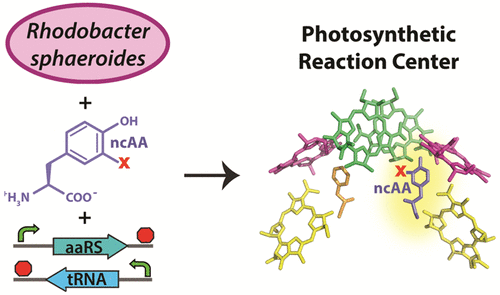当前位置:
X-MOL 学术
›
ACS Synth. Biol.
›
论文详情
Our official English website, www.x-mol.net, welcomes your
feedback! (Note: you will need to create a separate account there.)
Genetic Code Expansion in Rhodobacter sphaeroides to Incorporate Noncanonical Amino Acids into Photosynthetic Reaction Centers
ACS Synthetic Biology ( IF 3.7 ) Pub Date : 2018-05-15 00:00:00 , DOI: 10.1021/acssynbio.8b00100 Jared Bryce Weaver 1 , Steven G. Boxer 1
ACS Synthetic Biology ( IF 3.7 ) Pub Date : 2018-05-15 00:00:00 , DOI: 10.1021/acssynbio.8b00100 Jared Bryce Weaver 1 , Steven G. Boxer 1
Affiliation

|
Photosynthetic reaction centers (RCs) are the membrane proteins responsible for the initial charge separation steps central to photosynthesis. As a complex and spectroscopically complicated membrane protein, the RC (and other associated photosynthetic proteins) would benefit greatly from the insight offered by site-specifically encoded noncanonical amino acids in the form of probes and an increased chemical range in key amino acid analogues. Toward that goal, we developed a method to transfer amber codon suppression machinery developed for E. coli into the model bacterium needed to produce RCs, Rhodobacter sphaeroides. Plasmids were developed and optimized to incorporate 3-chlorotyrosine, 3-bromotyrosine, and 3-iodotyrosine into RCs. Multiple challenges involving yield and orthogonality were overcome to implement amber suppression in R. sphaeroides, providing insights into the hurdles that can be involved in host transfer of amber suppression systems from E. coli. In the process of verifying noncanonical amino acid incorporation, characterization of this membrane protein via mass spectrometry (which has been difficult previously) was substantially improved. Importantly, the ability to incorporate noncanonical amino acids in R. sphaeroides expands research capabilities in the photosynthetic field.
中文翻译:

球形红球菌的遗传密码扩展,以将非规范性氨基酸掺入光合反应中心
光合反应中心(RCs)是负责光合作用的初始电荷分离步骤的膜蛋白。作为复杂且在光谱上复杂的膜蛋白,RC(及其他相关的光合作用蛋白)将从探针形式的位点特异性编码的非规范氨基酸提供的见识以及关键氨基酸类似物中化学范围的增加中受益匪浅。为了实现这一目标,我们开发了一种方法,可以将为大肠杆菌开发的琥珀色密码子抑制机制转移到生产RC所需的模型细菌中,即球形球形红细菌。。开发并优化了质粒,以将3-氯酪氨酸,3-溴酪氨酸和3-碘酪氨酸掺入RC中。克服了涉及产量和正交性的多重挑战,可以在球形螺菌中进行琥珀抑制,为深入了解可能从大肠杆菌转移琥珀抑制系统的宿主提供了障碍。在验证非规范氨基酸掺入的过程中,通过质谱分析(以前很难做到)对该膜蛋白的表征得到了显着改善。重要的是,将非典型氨基酸掺入到球形红螺菌中的能力扩展了光合作用领域的研究能力。
更新日期:2018-05-15
中文翻译:

球形红球菌的遗传密码扩展,以将非规范性氨基酸掺入光合反应中心
光合反应中心(RCs)是负责光合作用的初始电荷分离步骤的膜蛋白。作为复杂且在光谱上复杂的膜蛋白,RC(及其他相关的光合作用蛋白)将从探针形式的位点特异性编码的非规范氨基酸提供的见识以及关键氨基酸类似物中化学范围的增加中受益匪浅。为了实现这一目标,我们开发了一种方法,可以将为大肠杆菌开发的琥珀色密码子抑制机制转移到生产RC所需的模型细菌中,即球形球形红细菌。。开发并优化了质粒,以将3-氯酪氨酸,3-溴酪氨酸和3-碘酪氨酸掺入RC中。克服了涉及产量和正交性的多重挑战,可以在球形螺菌中进行琥珀抑制,为深入了解可能从大肠杆菌转移琥珀抑制系统的宿主提供了障碍。在验证非规范氨基酸掺入的过程中,通过质谱分析(以前很难做到)对该膜蛋白的表征得到了显着改善。重要的是,将非典型氨基酸掺入到球形红螺菌中的能力扩展了光合作用领域的研究能力。











































 京公网安备 11010802027423号
京公网安备 11010802027423号